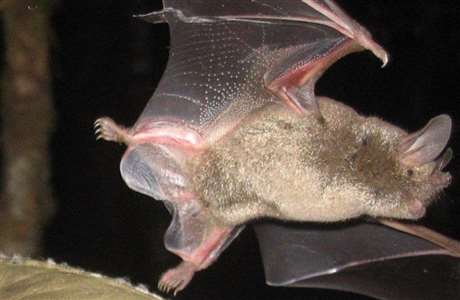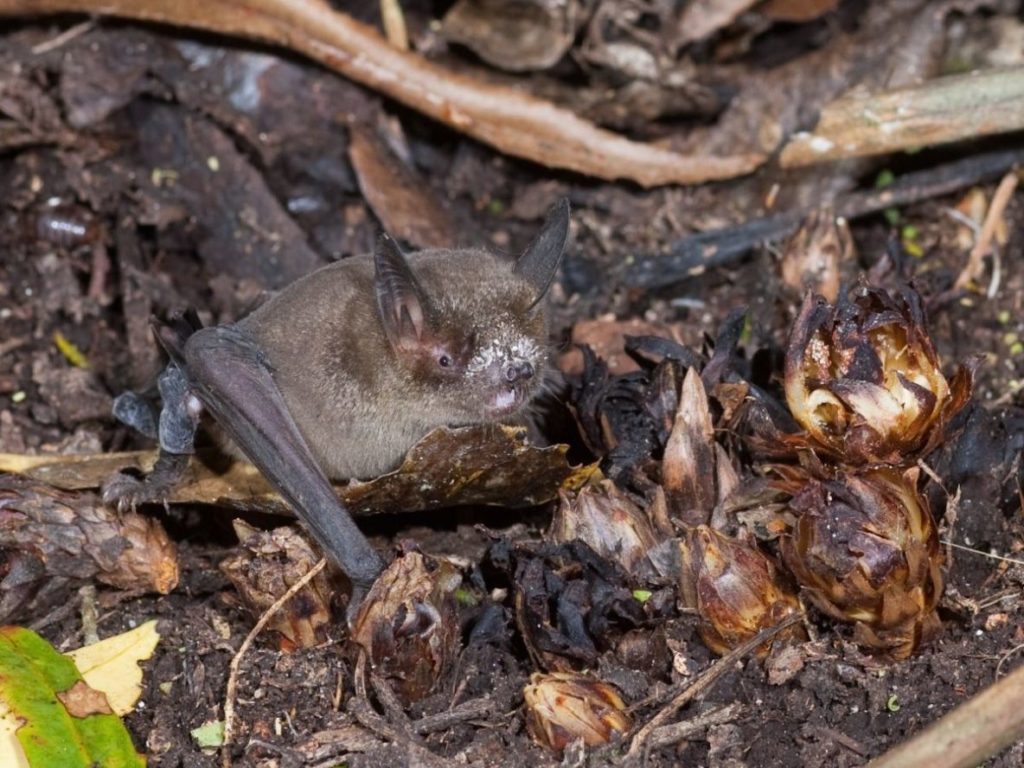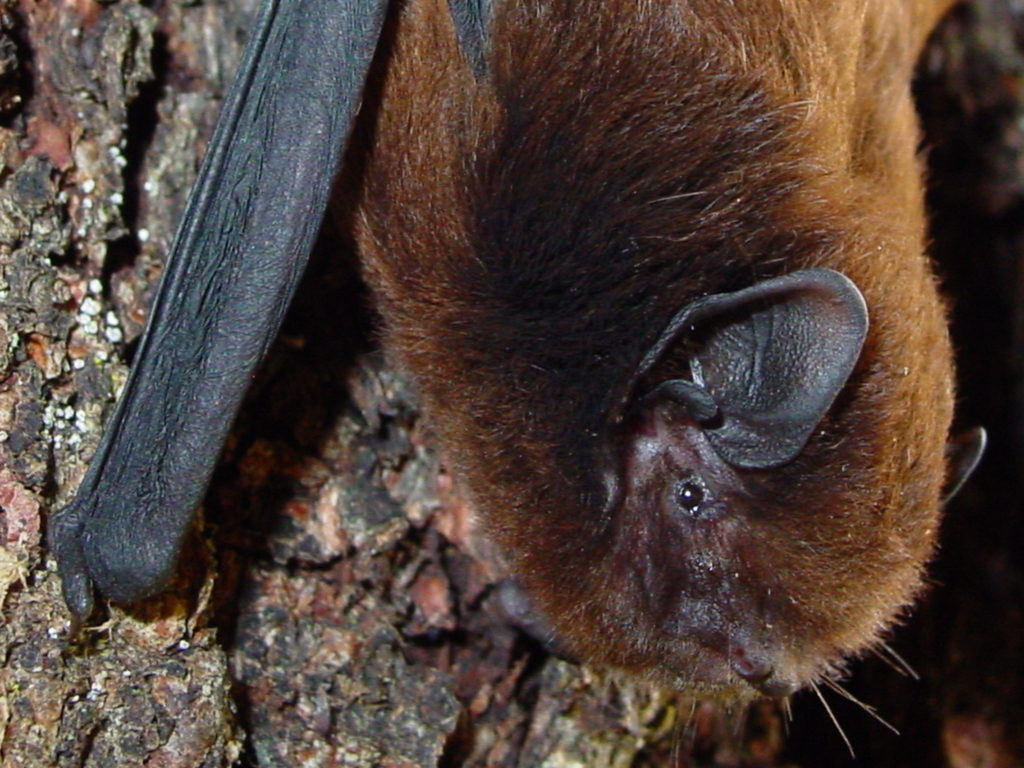Let’s be honest – New Zealand’s wildlife is weird. There are alpine weta that can freeze and thaw, kiwi with their amazing sense of smell and mammal-like behaviour, booming kakapo, carnivorous snails – and then there are our bats.
The closest relatives of our short-tailed bats live in tropical locations. Our little short-tailed bat is sometimes active when temperatures are below freezing, foraging in the leaf-litter even in the presence of snow.

Some bat species in other parts of the world hibernate when conditions get tough. Our two bat species slow down to conserve energy when necessary, entering a state of short-term torpor, but do they truly hibernate?
Scientists Brian McNab (University of Florida) and Colin O’Donnell (Department of Conservation) investigate the behavioural energetics of our long-tailed and short-tailed bats in a paper published last year in the journal Comparative biochemistry and physiology. Part A, Physiology.
So just how different are Aotearoa’s only land mammal species?
Firstly, a little more on the characteristics of our lesser short-tailed bats, (Mystacina tuberculata, family Mystacinidae).
The Mystacinidae has 5 distinctive characteristics:
- Gondwana ancestry: “Based on DNA hybridization studies and nuclear gene sequences, this family is closely related to five families found exclusively in the Neotropics. Collectively these families constitute the superfamily Noctilionoidea, which also includes the Myzopodidae in Madagascar and formerly in Africa. This pattern of affiliation and distribution reflects a shared Gondwana ancestry.”
- Resemble ‘primitive’ evolutionary ancestors: “Mystacinidae is one of several taxa endemic to New Zealand that are close to the evolutionary base of their phylogenetic groups, including parrots, passerines, kiwis, the tuatara, and leiopelmatid frogs.”
- Diverse food habits: “Mystacina, unlike other temperate bats, has diverse food habits, including flying insects, terrestrial invertebrates, fruit, nectar, and pollen.”
- Cold weather activity: “It crawls on the ground and digs burrows in the soil and decaying trees, even in the presence of snow.”
- Walks on ‘all fours’: “Terrestrial activity is facilitated by folding their wings in thickened flight membranes, which combined with robust hind legs and feet, permits four-appendage walking.”

New Zealand’s other bat species, the long-tailed bat (Chalinolobus tuberculatus, family Vespertilionidae), belongs to a completely different branch of the wider ‘bat family’.
“Chalinolobus, like most vespertilionids, has a diet of flying insects, a food resource that is often unavailable on a seasonal and short-term basis. In response, this species and other vespertilionids enter torpor, which in the coldest climates, is extended to hibernation.”
Short-tailed and long-tailed – two very different bat species sharing the same ‘islands at the bottom of the world’ location – so how similar are their responses to the conditions they find themselves in?
“We examine the impact of behaviour on the short-term energy expenditures of the only terrestrial mammals endemic to New Zealand, two bats, the long-tailed (Chalinolobus tuberculatus, family Vespertilionidae), and the lesser short-tailed (Mystacina tuberculata, family Mystacinidae). Vespertilionidae has a world-wide distribution. Mystacinidae is restricted to New Zealand. Both species have highly variable body temperatures and rates of metabolism.”
One thing they do have in common is a need to shelter during cold, wet weather.
“They feed on flying insects, which requires them to be torpid in shelters during cold, wet periods. We examine the short-term response in summer to the environment that the New Zealand species share, that is when not facing the harshest conditions encountered in winter, or during extended periods of rainfall. How similar are the responses of Mystacina and Chalinolobus to their shared environment, given their different phylogenetic affinities?”
Research was carried out in the lower Eglinton Valley in Fiordland.
“This region is a cool, wet, temperate environment characterized by extensive mountain ranges covered by a southern beech forest, occasionally with snowfall in the valley. We captured both species using free-standing harp traps and mist nets on their foraging grounds at dawn during the austral summer (26 Feb. – 10 March 2016) after breeding had finished.”
The energy expenditure of captured bats was measured in a process that could take up to nine hours.
“Measurements of energy expenditure were made in the laboratory in the morning five to seven hours after capture during the bat’s period of inactivity. Individuals were placed in a dark chamber through which room air was drawn. Bats were exposed to ambient temperatures between 9 and 34°C. Measurements always started with an exposure to room temperatures, then exposed to warmer or colder temperatures, returned to room temperature, and again exposed to warm or cold temperatures. An exposure continued until the oxygen consumption was constant for at least 1 to 2 hours.”
“At the end of each exposure, rectal temperature was measured by a thermocouple. After the measurements, the bats were released at night where they were captured. Two Mystacina were kept for a second day without food to indicate whether their response to ambient temperature differed from that shown on the first day.”
The body temperature in both bat species was highly variable – but more variable in the short-tailed bats, than the long-tailed.
“The body temperature in six long-tailed bats was highly variable. At chamber temperatures between 12 and 25°C, body temperature either was maintained between 27 and 33°C, or it decreased to within 3°C of ambient temperature. The rate of metabolism was highly variable, increasing with the variation in body temperature.
“Body temperature of eight lesser short-tailed bats, was highly variable at all chamber temperatures, a variability greater than found in Chalinolobus. Body temperatures of individuals held for a second day at ambient temperatures >15°C were similar to those obtained on the first day, but lower at lower ambient temperatures. The correlation of the rate of metabolism with body temperature in Mystacina is similar to that in Chalinolobus.”
So what does that mean in terms of life in the real world of wet cold days and changeable weather?
“The use of torpor generally depends on a series of factors, including body mass, ambient temperature, latitude, reproductive cycle, sociality, and fat deposits. These factors result in a diversity of responses that range along a continuum from short-term torpor to hibernation.”
“The short-term flexible energy expenditures of these species reflect the reduced foraging opportunities that result from cold and wet conditions that occasionally occur in summer. To examine the consequences of missing a day of foraging, two Mystacina were kept for a second day. Both body temperature and rate of metabolism were similar to first day measurements at ambient temperatures>20°C. But the rates of metabolism were depressed at lower ambient temperatures, a response that would expand as inclement weather persisted.”
“In dry weather Mystacina is active in winter at ambient temperatures as low as −1.0°C, foraging for terrestrial invertebrates in leaf litter, even in the presence of snow, and consuming fruit, nectar, and pollen from endemic plants that bloom in winter. The behaviour of Mystacina expands its presence in a cool, wet, temperate forest in a manner unlike any other bat, another example of the distinctive characteristics of the endemic New Zealand fauna.”
So what about the long-tailed bats? Their metabolic response to temperature change in the testing chamber was similar, although not quite as variable as that of short-tailed bats. But back in the Fiordland forest the differences are more obvious.

“The near physiological similarity of the New Zealand species in the controlled environment of a metabolism chamber does not imply that they respond to conditions in the environment in an identical manner. Unlike hibernating bats, these species forage in winter when circumstances permit, but their responses to cold environmental temperatures are strikingly different.”
Food choices are a key factor.
“The problem faced by both species is that the supply of flying insects is diminished at low ambient temperatures, which requires them to use torpor and tree-hollow roosts. In the Eglinton Valley, flight in Chalinolobus and insect activity were reduced at ambient temperatures <10°C, which almost completely stopped when ambient temperatures <5°C. Winter activity in Chalinolobus is <5% that of summer activity. Its prey in summer predominantly consisted of beetles, moths, and flies, which operate at higher body temperatures than other flying insects.”
“The activity of Mystacina also decreases with ambient temperature. In Eglinton Valley, it was active in winter about one-quarter of the time compared to summer, five times the proportion in Chalinolobus. In fact, Mystacina is often active at air temperatures between −1.4 and 8.9°C. Sedgeley (2001) observed that 33% of radio-tagged Mystacina were active on the coldest nights (−1.0°C).”
Short-tailed bats show a greater independence of environmental temperature – and include ground-living insects in their diet when flying insects are absent.
“It’s propensity to maintain larger temperature differentials at chamber temperatures <20°C correlates with its greater independence of temperature in the field. Mystacina in winter exploits terrestrial prey at low ambient temperatures in the absence of flying insects. To capture this prey, Mystacina spends up to 40% of the time foraging under litter, even in the presence of snow. Consequently, 40 to 60% of the diet of Mystacina in winter is terrestrial arthropods (including two families of orthopterans endemic to New Zealand, the wetas) and spiders, the activities of which do not require high ambient and body temperatures.”
Short-tailed bats also extend their diet to include pollen and nectar – meaning they are able to continue finding food and conserving energy through torpor is not so necessary for them.
“This opportunistic response by M. tuberculata may have been expanded by its larger, extinct relative M. robusta, which weighed 25 to 35g, may have been carnivorous, possibly feeding on carrion, nestlings, and small birds, although the extent to which this occurred is unclear. The behaviour of the two species of Mystacina permitted them to exploit resources in a temperate environment unlike other bats.”
So do New Zealand’s bats hibernate? Not really… but they do use short-term torpor to get through the toughest patches of wet summers and cold winters.
“Mystacina remained in torpor up to 10 days, more frequently in winter than in summer. Adult Chalinolobus of both sexes in summer entered torpor on 80% of days for approximately 12 hours, when roosting alone, and 35% of days for approximately 9 hours, reflecting roosting in groups. This behaviour differs from species hibernating in cold, temperate caves in the Northern Hemisphere, where in a cave population half of the individuals awake after 20 to 90 days of continuous torpor.”
So what might climate change mean for our bats?
“The adjustment made by Mystacina to a temperate environment can be put into the context of its potential response to the impact of climate warming. One response might be to reduce the time spent in torpor under the assumption that torpor in this species simply is a means of avoiding harsh environmental conditions. If the increase in temperature is marked, its potential occupation of some subantarctic islands is possible, but that would be possible only if appropriate resources were available, including a forest of sufficient size and diversity.”
The article is published in the journal: Comparative biochemistry and physiology. Part A, Physiology. The full text can be downloaded through Researchgate:
The behavioral energetics of New Zealand’s bats: Daily torpor and hibernation, a continuum (2018)

